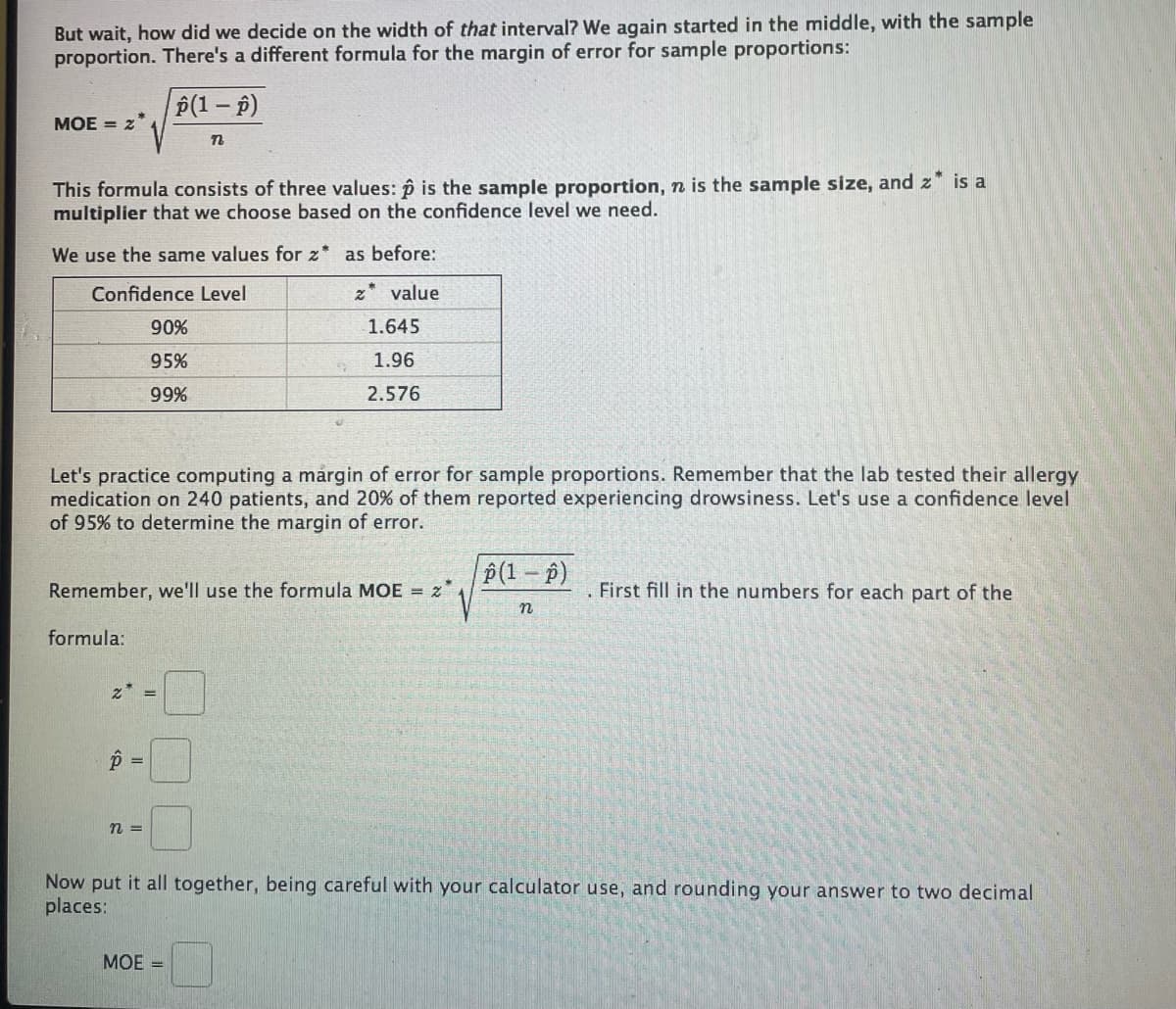oportion. There's a different formula for the margin of error for sample proportio p(1-p) DE = 2*. n is formula consists of three values: p is the sample proportion, n is the sample size, and z is a ultiplier that we choose based on the confidence level we need. e use the same values for z* as before: Confidence Level z value 90% 1.645 95% 1.96 99% 2.576 's practice computing a margin of error for sample proportions. Remember that the lab tested their allergy dication on 240 patients, and 20% of them reported experiencing drowsiness. Let's use a confidence lev 95% to determine the margin of error. p(1-p) member, we'll use the formula MOE = z. . First fill in the numbers for each part of the n mula: z = p= n = w put it all together, being careful with your calculator use, and rounding your answer to two decimal ces: MOE =
oportion. There's a different formula for the margin of error for sample proportio p(1-p) DE = 2*. n is formula consists of three values: p is the sample proportion, n is the sample size, and z is a ultiplier that we choose based on the confidence level we need. e use the same values for z* as before: Confidence Level z value 90% 1.645 95% 1.96 99% 2.576 's practice computing a margin of error for sample proportions. Remember that the lab tested their allergy dication on 240 patients, and 20% of them reported experiencing drowsiness. Let's use a confidence lev 95% to determine the margin of error. p(1-p) member, we'll use the formula MOE = z. . First fill in the numbers for each part of the n mula: z = p= n = w put it all together, being careful with your calculator use, and rounding your answer to two decimal ces: MOE =
College Algebra
7th Edition
ISBN:9781305115545
Author:James Stewart, Lothar Redlin, Saleem Watson
Publisher:James Stewart, Lothar Redlin, Saleem Watson
Chapter9: Counting And Probability
Section9.3: Binomial Probability
Problem 2E: If a binomial experiment has probability p success, then the probability of failure is...
Related questions
Question

Transcribed Image Text:But wait, how did we decide on the width of that interval? We again started in the middle, with the sample
proportion. There's a different formula for the margin of error for sample proportions:
p(1 - p)
MOE = z
n
This formula consists of three values: p is the sample proportion, n is the sample size, and z is a
multiplier that we choose based on the confidence level we need.
We use the same values for z* as before:
Confidence Level
z* value
90%
1.645
95%
1.96
99%
2.576
Let's practice computing a margin of error for sample proportions. Remember that the lab tested their allergy
medication on 240 patients, and 20% of them reported experiencing drowsiness. Let's use a confidence level
of 95% to determine the margin of error.
p(1 - p)
Remember, we'll use the formula MOE = 2*
First fill in the numbers for each part of the
n
formula:
z =
p =
n =
Now put it all together, being careful with your calculator use, and rounding your answer to two decimal
places:
MOE =
S
Expert Solution
This question has been solved!
Explore an expertly crafted, step-by-step solution for a thorough understanding of key concepts.
Step by step
Solved in 2 steps with 1 images

Recommended textbooks for you

College Algebra
Algebra
ISBN:
9781305115545
Author:
James Stewart, Lothar Redlin, Saleem Watson
Publisher:
Cengage Learning

Holt Mcdougal Larson Pre-algebra: Student Edition…
Algebra
ISBN:
9780547587776
Author:
HOLT MCDOUGAL
Publisher:
HOLT MCDOUGAL

College Algebra (MindTap Course List)
Algebra
ISBN:
9781305652231
Author:
R. David Gustafson, Jeff Hughes
Publisher:
Cengage Learning

College Algebra
Algebra
ISBN:
9781305115545
Author:
James Stewart, Lothar Redlin, Saleem Watson
Publisher:
Cengage Learning

Holt Mcdougal Larson Pre-algebra: Student Edition…
Algebra
ISBN:
9780547587776
Author:
HOLT MCDOUGAL
Publisher:
HOLT MCDOUGAL

College Algebra (MindTap Course List)
Algebra
ISBN:
9781305652231
Author:
R. David Gustafson, Jeff Hughes
Publisher:
Cengage Learning